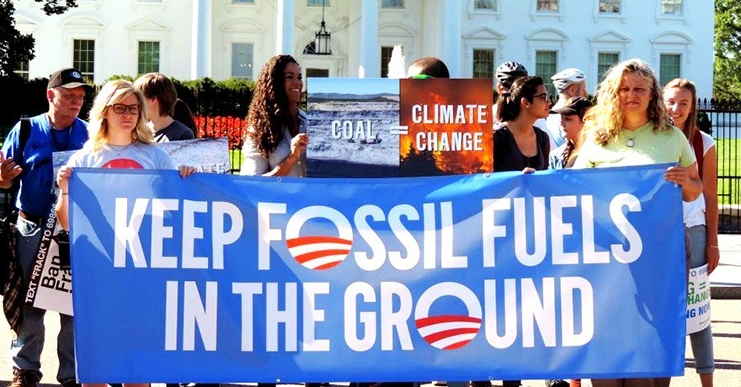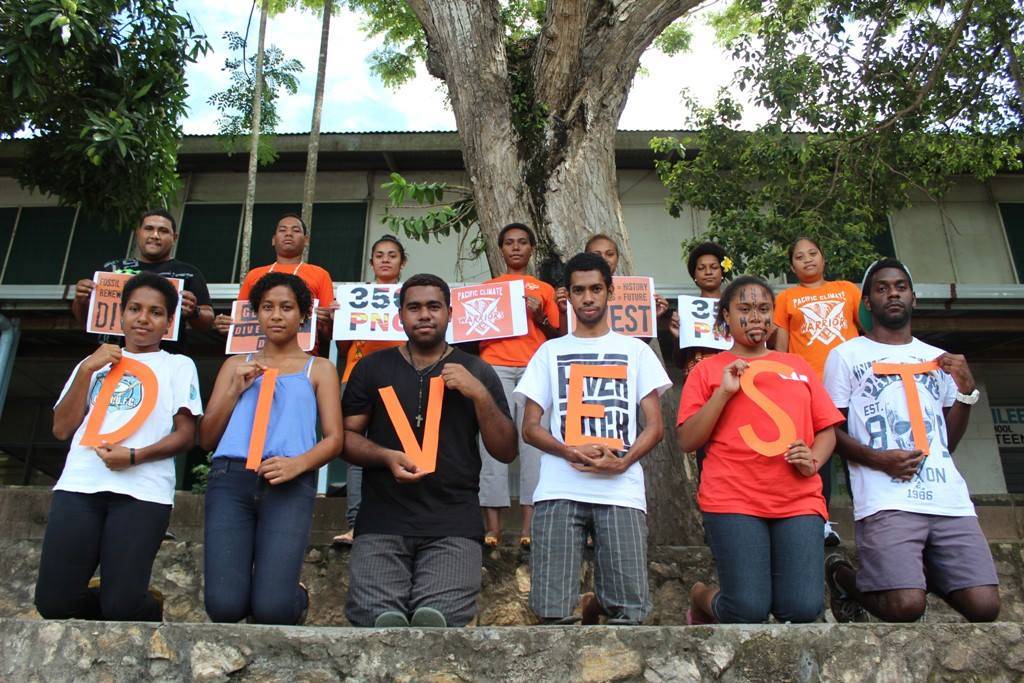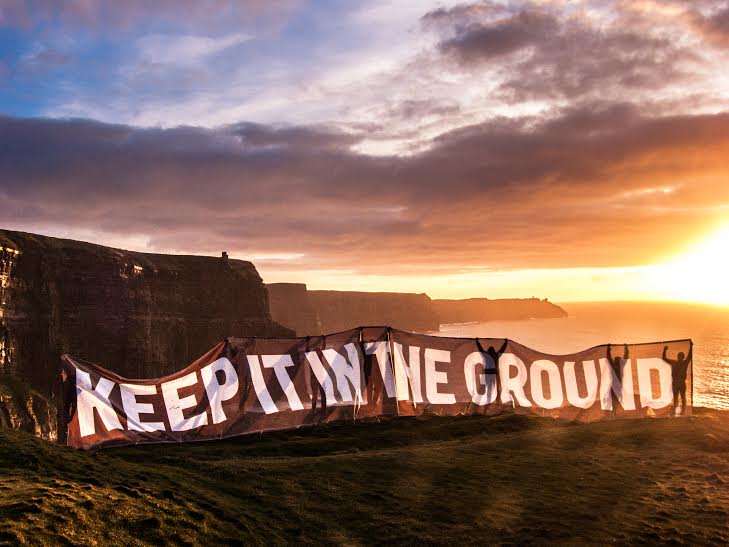Join the Movement. It’s Time to Break Free from Fossil Fuels.
By Bill McKibben
Physics can impose a bracing clarity on the normally murky world of politics. It can make things simple. Not easy, but simple.
Most of the time, public policy is a series of trade-offs: higher taxes or fewer services, more regulation or more freedom of action. We attempt to balance our preferences: for having a beer after work, and for sober drivers. We meet somewhere in the middle, compromise, trade off. We tend to think we’re doing it right when everyone’s a little unhappy.
But when it comes to climate change, the essential problem is not one group’s preferences against another’s. It’s not—at bottom—industry versus environmentalists or Republicans against Democrats. It’s people against physics, which means that compromise and trade-off don’t work. Lobbying physics is useless; it just keeps on doing what it does.
So here are the numbers: We have to keep 80 percent of the fossil-fuel reserves that we know about underground. If we don’t—if we dig up the coal and oil and gas and burn them—we will overwhelm the planet’s physical systems, heating the Earth far past the red lines drawn by scientists and governments. It’s not “we should do this,” or “we’d be wise to do this.” Instead it’s simpler: “We have to do this.”

And we can do this. Five years ago, “keeping it in the ground” was a new idea. When environmentalists talked about climate policy, it was almost always in terms of reducing demand. On the individual level: Change your light bulb. On the government level: Put a price on carbon. These are excellent ideas, and they’re making slow but steady progress (more slowly in the United States than elsewhere, but that’s par for the course). Given enough time, they’d bring down carbon emissions gradually but powerfully.
Time, however, is precisely what we don’t have. We pushed through the 400 parts per million level of CO2 in the atmosphere last spring; 2015 was the hottest year in recorded history, smashing the record set in … 2014. So we have to attack this problem from both ends, going after supply as well as demand. We have to leave fossil fuel in the ground.
Most of that coal and oil and gas—most of that money—is concentrated in a few huge underground pools of carbon. There’s oil in the Arctic, and in the tar sands of Canada and Venezuela, and in the Caspian Sea; there’s coal in Western Australia, Indonesia, China, and in the Powder River Basin; there’s gas to be fracked in Eastern Europe. Call these the “carbon bombs.” If they go off—if they’re dug up and burnt—they’ll wreck the planet. Of course, you could also call them “money pits.” Lots of money—that coal and gas and oil may be worth $20 trillion. Maybe more.
Because of that, there are people who say that the task is simply impossible—that there’s no way the oil barons and coal kings will leave those sums underground. And they surely won’t do it voluntarily. Take the Koch brothers, for instance: They’re among the largest leaseholders in Canada’s tar sands and plan nearly $900 million in political spending during 2016, more than the Republicans or the Democrats. Because they won’t be among the richest men on Earth anymore if that oil stays beneath the ground.
But in fact it’s not a hopeless task. We’ve begun to turn the tide, and in remarkably short order.
If you understand the logic of the Keep It in the Ground campaign, for instance, then you understand the logic of the Keystone pipeline fight. Pundits said it was “just one pipeline,” but efforts to block it meant that the expansion of Canada’s tar sands suddenly, sharply slowed. Investors, unsure that there would ever be affordable ways to bring more of that oil to market, pulled tens of billions of dollars off the table, even before the price of oil began to fall. So far, only about 3 percent of the oil in those tar sands has been extracted; the bomb is still sitting there, and if we block pipelines, then we cut the fuse.
And the same tactics are working elsewhere, too. In Australia, there was unrelenting pressure from indigenous groups and climate scientists to block what would have been the world’s largest coal mine in Queensland’s Galilee Valley. Activists tied up plans long enough that other campaigners were able to pressure banks around the world to withdraw financing for the giant mine. By spring 2015, most of the world’s major financial institutions had vowed not to provide loans for the big dig, and by summer the mining company was closing down offices and laying off its planning staff.
Money, in fact, is a key part of the Keep It in the Ground strategy. In fall 2012, students, faith leaders, and other activists launched a fossil-fuel divestment campaign in the United States, supported by 350.org (an organization I co-founded), that soon spread Down Under and to Europe. The argument was simple: If Exxon and Chevron and BP and Shell plan to dig up and burn more carbon than the planet can handle, they’re not normal companies.
If their business plan would break the planet, then we need to break ties with them.
At first, the institutions that joined in were small. Tiny Unity College in Maine was first, selling the fossil fuel stock in its $13 million portfolio. But the campaign accelerated quickly because the math was so clear, the physics so irrefutable. By now colleges from Stanford to Oxford, from Sydney to Edinburgh, have joined in, pointing out that it makes no sense to educate young people and then break the planet they’ll inhabit. Ditto doctors associations on several continents, which argue that you can’t pretend to be interested in public health if you invest in companies destroying it. Ditto the United Church of Christ and the Unitarians and the Church of England and the Episcopalians, who insist that care for creation is incompatible with such destruction.

These divestments are hurting companies directly—coal giant Peabody formally told shareholders in 2014 that the campaign was affecting its stock price and making it hard to raise capital. But even more, they’ve driven the necessity of keeping carbon underground from the fringes into the heart of the world’s establishment. The Rockefeller Brothers Fund started divesting its fossil fuel stocks, while Deutsche Bank, the World Bank, and the International Monetary Fund have started down the same road. A month after the Rockefeller announcement, the governor of the Bank of England told a conference that “the vast majority” of carbon reserves are “unburnable,” warning of massive “stranded assets.” Trying to get out from under this “carbon bubble” is one reason why huge funds are now beginning to divest. The California Public Employees’ Retirement System, for instance, lost $5 billion before it saw the light and started selling its stock.
But the fight remains damnably hard, because politicians are so used to doing the bidding of the oil companies. In fact, just days after the theoretically landmark Paris climate accord, the Obama administration and Congress gave the oil industry a much-sought-after gift: ending the 40-year ban on crude oil exports. We’re making progress (it was something of a breakthrough, for instance, when cautious Hillary Clinton came out against Arctic oil) but not fast enough.
Which is why, this spring, the climate movement will be rallying on the sites of as many of those carbon bombs as possible, in massive peaceful resistance designed to slow extraction of fossil fuels, but even more to shine a light on these massive, remote deposits. The leaders, as always, will be the frontline communities that live nearby. Some of the rest of us will make the trek to these locations; others will rally at embassies and banks to bring the same point home. Because once we’ve marked them on the planet’s mental map as mortal dangers, our odds of winning go up.
If you’re still skeptical, consider what happened in the Amazon after the world’s scientists, in the 1980s, identified the rainforest as absolutely necessary to the planet’s survival. Much to the surprise of many, the government of Brazil moved to slow deforestation. Its efforts haven’t been perfectly successful, but they’ve kept those trees above the ground, just the way we need to keep that oil below it.
And we’ve got a couple of advantages in this fight the Brazilians didn’t. For one, they were a poor country. Many of the big carbon bombs lie in richer nations like Canada, the United States, and Australia; we can afford to let them be.
More importantly, it’s beginning to look like we don’t need to win this fight forever. That’s because alternatives to fossil fuel are becoming cheaper with every passing day. The price of a solar panel has fallen more than 70 percent in the last six years. That’s a mortal threat to the hydrocarbon tycoons. They know that they have to get new infrastructure in place in the next few years. If they can build those pipelines and mines, then for the next 40 or 50 years they’ll be able to get carbon out cheaply enough to compete (and to wreck the planet). If they can’t—if we can hold them off for just a few more years—then we’ll have made the transition to clean energy irreversible.
I don’t know if we’re going to win this fight in time. The flood of scientific data about the damage that’s already been done unnerves me. But I do know we’re now fighting on every front. And the most important one is the simplest: We can, and we must, and we will keep that coal and gas and oil underground.
